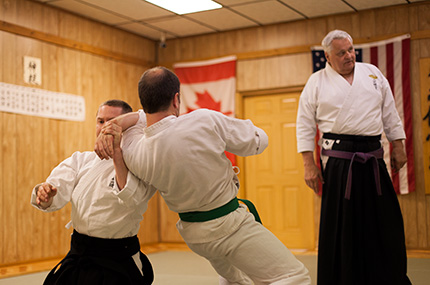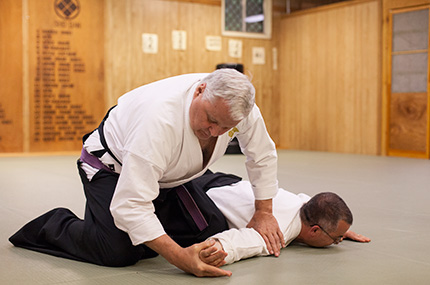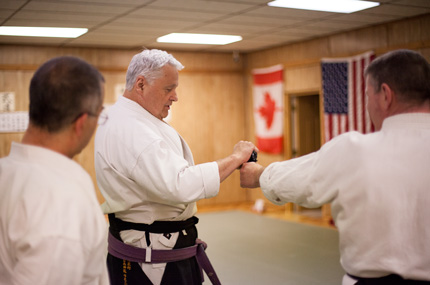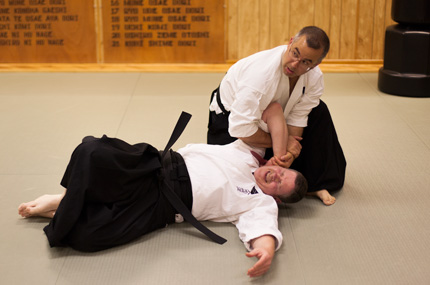
Are you interested in, or are you trying to find out what our martial art (Hakko Denshin Ryu Jujutsu) is all about? Do you want to learn how to properly defend yourself without causing serious injury to another person? If you have answered "Yes" to all of these questions, then you've come to the right martial art and dojo......The Eighth Light Dojo.
Class Schedules
Wednesdays: 7:00pm - 8:30pm
Saturday: 10:00am - 11:30pm
What Jujutsu Is About

At the Eighth Light Dojo, we teach adult students how to protect themselves without doing serious harm to an attacker by using one or more of a series of wrist techniques. Our main goal is to teach self-defense and prevention, not to promote competition. We feel that it’s wrong to compete because you are then taking away the true meaning of the martial art’s intent - Self-Defense. Jujutsu is unique in itself because it means the “Gentle Art.” It also has been translated to mean.... “Softness”, ”Loving-Likeness”, and “Yielding.” For your information, here’s what Jujutsu itself is actually made up of - It has all the punches and kicks of Karate, all the throws, sweeps, armbars, and chokes of Judo, and then there’s Jujutsu itself, which consists of unique wrist locking and joint locking techniques that are used to control an attacker. Jujutsu also incorporates Ground fighting, plus the utilization of various traditional Samurai Weapons. Jujutsu originated from Japan and we can trace our style of Jujutsu all the way back to the 8th Century A.D. In Japan, Jujutsu has been termed the “Ultimate” martial art because of its versatility, plus the fact that it was actually developed on the battlefield - it was a Samurai’s last means of self defense, especially if they lost all of their weapons. Ok, so you have some background about Jujutsu, but here’s what training is actually like at our dojo.
Training At Our Dojo

When an adult student first starts training, they wear a White Belt and begin at the “Shodan” level, which in Japanese means - “First-Degree.” Before an Adult Student starts doing self-defense principles and techniques, they learn how to do shoulder rolls and break falls. The reason for learning these is that in jujutsu, proper shoulder rolling and break faling can mean the difference from coming out of an attack non-injured, especially if you as the non-attacker, gets thrown, or pushed down to the ground in a scuffle of some sort. After learning how to properly break fall and shoulder roll, adult students are taught how to do kicks, punches, defensive positions, and stances. After an adult student learns the “essentials” metioned above, they are introduced to Shodan Basic “Waza”, which is a Japanese term that means “Basic Technique or Movement.” At the Shodan Level, adult students are taught 21 basic movements in the sitting, half-standing, and standing positions.
Within Shodan Waza, there’s 7 fundamental principles that are taught and learned by an adult student. They are:
- Hakko Dori - ”Eighth Light Art - Escaping"
- Atemi - "Light Striking To The Body"
- Te-Kagami - "Hand Mirror - A Turning Wrist Bend"
- Nage - "Causing or Making an Attacker Stumble or Fall"
- Ni-Ho Nage - "Two Way Throw, or using a wrist lock to throw an Attacker"
- Osae Dori - "The Shodan Wrist Bend"
- Otoshi - "Throwing an Attacker using one's body as a Fulcrum"
How Class Is Taught

During a typical Adult Class, a variety of self-defense applications are worked on. Usually, half of the class is dedicated to teaching the Adult Student “Waza” and letting them practice, while the other half of class is used for applying and practicing self-defense situations using the techniques and principles learned from “Waza.” Additionally, Adult Students are taught how to defend against guns, knives, bottles, clubs, bats, and sticks, using one of many wrist locks that an Adult Student learns, depending on what “Degree” you are studying. Sometimes, groundfighting applications are taught and worked on to an extent, utilizing the various techniques and principles that come from “Waza.” Also, some of the tradiional Samurai weapons are taught every so often and one popular weapon that is taught s the Jo, which is a 4 foot, 2 inch staff, constructed of a hardwood, usually Oak. Another weapon that is taught is the Bokken, which is a wooden-replicated Samurai sword made of a hardwood (example - Oak), that is used by an Adult Student for practicing “drawing” and “cutting” techniques as the traditional Samurai once did. We teach these weapons as a mean of self-defense and not for offensive purposes. Learning weapons, such as the Jo and Bokken, help develop an Adult Student’s concentration and discipline, while also incorporating various body movements and stances, which are similarly used in regular jujutsu applications.
The “Senseis’ ” Who Teach
Hakko Denshin Ryu Jujutsu is primarily taught by Soke Menkyo Kaiden-Shihan San Dai Kichu - Michael J. LaMonica, who is the highest ranking non-oriental in the World of this Art. He teaches on Wednesday’s and Saturday’s. Sensei Dave (Shihan) teaches on Monday’s, Usually, Tuesday’s and Thursday’s are considered the “Beginner” classes, while Monday’s, Wednesday’s, and Saturday’s are considered the “Advanced” Classes. All Adult Students are welcome to attend any of these days, but it’s recommended that as a Beginner, you attend Tuesday’s or Thursday’s, so you can get your feet wet and learn what Hakko Denshin Ryu Jujutsu is all about. Soke LaMonica’s wife, Shihan Chris LaMonica, heads up the Youth Class on Wednesday’s and Saturday’s.
Belt Ranking/Testing
Adult Students make progress by moving up in belt color. This is done by testing. Generally, if you are a white belt (beginner), your next belt you will test for is yellow. Here, you will be asked to do all 21 Shodan Waza, to see how proficient your Waza has gotten. Every time you test for a belt, or the higher you go, your Waza will be expected to be smoother and smoother, until it is at near perfection (this is when you would test for Black Belt). You will also be asked to do self-defense applications using the 7 principles mentioned above. Belt ranks are as follows: White, Yellow, Orange, 2 Greens, 3 Browns, and finally Black. Once Black Belt is achieved, you are considered a 1st Degree Black Belt, or termed in Japanese - a Shodan Black Belt. To test for your Black Belt, you need to be at least 16 years of age and the reason for this is that we don’t want a young student to use his or her knowledge the wrong way. We feel that this is a suitable age for him or her to test for their Black Belt because they will be at a more mature level and have had approximately 2 years of training. If an Adult Student receives a Black Belt, their training isn’t completed at all! If he or she wants, they will be permitted to study for their 2nd Degree Black Belt - which is termed Nidan. What’s really great and unique about our martial art (Hakko Denshin Ryu Jujutsu) is that for each rank of Black Belt an Adult student studies, they learn a whole new set of Waza and wrist locks/principles. If a student tests for their Nidan Black Belt and passes, they will be permitted to study Sandan, translated to 3rd Degree Black Belt. If an Adult Student passes Sandan, they will be permitted to study Yondan, or 4th Degree Black Belt. After Yondan, then they will begin their training towards Shihan, or Master Rank. This is by invitation only. What is taught beyond Yondan (4th Degree) is a mystery and only those Adult Students who pass their Yondan test will find out.

